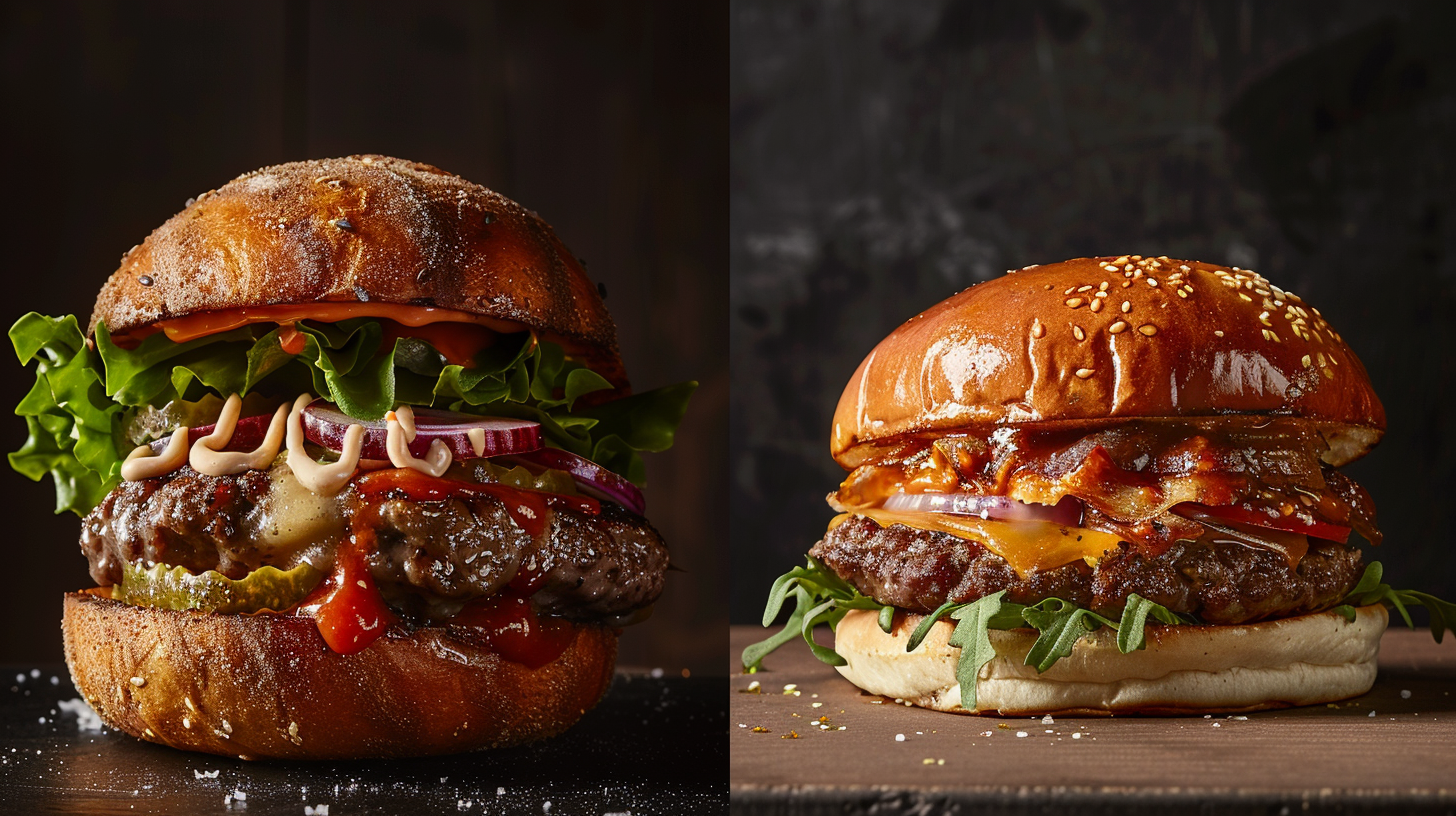Contents
- Key points
- Importance of Visual Appeal in Food
- Overview of the Guide’s Purpose and Structure
- Camera Selection: DSLR vs. Smartphone
- Lighting Equipment: Natural vs. Artificial
- Lenses and Tripods for Stability and Focus
- Rule of Thirds in Food Styling
- Choosing the Right Angle for Your Burger Shot
- Balancing Elements for an Attractive Composition
- Selecting Backgrounds and Surfaces
- Incorporating Props and Ingredients
- Creating a Theme Around Your Burger
- Making the Most of Sunlight for Genuine Shots
- Working with Shadows and Highlights
- Controlling Exposure for the Right Mood
- Top Tips for Sharing on Social Media
- Tags & SEO: Get Your Burger Photos Seen
- Joining the Food Photography Circle
- Frequently Asked Questions (FAQ)
Key points
• Lighting: Good lighting is key in taking pictures of burgers because it shows off the textures and colors, making the photo look tasty.
• Composition: How you arrange the burger and extras should be planned to make a pleasing picture that catches the eye.
• Styling: Styling means carefully placing the toppings and using extras to make the burger look great, sometimes making some parts look bigger or better for the camera.
Importance of Visual Appeal in Food
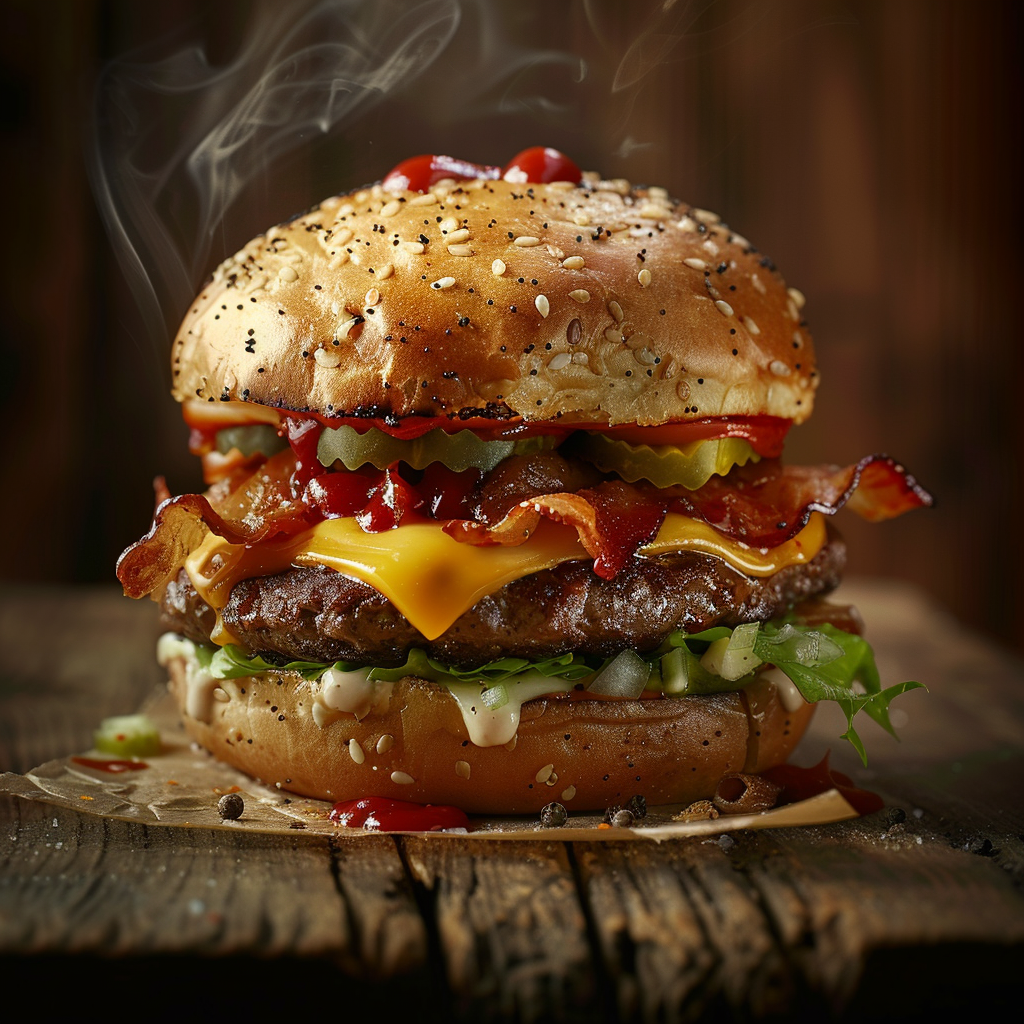
Eating with our eyes is pretty important. We live in a world where looks count for a lot, and that goes for our food too. A good photo can turn heads, even when it comes to a burger. People might walk right past a stand without giving it a second thought, but if they see a tasty-looking pic, they could stop on their heels and give it a go.
Overview of the Guide’s Purpose and Structure

This guide gives practical tips for photographers, who may be hobbyists or pros, on how to take amazing burger photos. We cover everything from camera settings basics to the finer points of framing and editing your shots. Anyone looking to get better at taking pictures of food will find this guide packed with useful stuff.
Camera Selection: DSLR vs. Smartphone
Picking the right camera is key to nailing that awesome burger photo. A DSLR camera gives you lots of control over things like exposure and focus, which helps if you’re into capturing every little detail. However, don’t count out smartphones – they’ve come a long way and now have some pretty good cameras that can do a solid job too. Your final pick might depend on how picky you are about details and whether you know your way around camera gear.
Lighting Equipment: Natural vs. Artificial
When we talk about food photography, lighting is a big deal, and burgers are no different. The light on an overcast day can work wonders, showing off your burger’s textures and colors without harsh shadows. That’s what natural light does best. If you want to be in charge no matter the time or weather, then artificial lights are your friend. You’ve got options like ring lights, softboxes, or umbrellas, which let you play with shadows and light as you like.
Lenses and Tripods for Stability and Focus
The lens you choose can make or break your burger photos. Prime lenses with a wide aperture ensure the burger stands out with a fuzzy background. Macro lenses are great for up-close shots that make you want to reach out and touch the burger. Now, shaky hands won’t cut it when you’re trying to photograph a towering burger; that’s why a tripod is essential. It keeps everything steady, especially when you’re shooting in dim light or need long exposure times, so your photo stays nice and sharp.
Framing a burger shot turns a simple sandwich into something you can’t wait to sink your teeth into. It’s not just a point-and-click thing; it’s more about arranging things in the picture to really show off the burger.
Rule of Thirds in Food Styling
The rule of thirds is super important for food photography, especially burgers. Picture your image split into nine parts by lines. Put your burger on these lines or where they cross to get a photo that feels balanced and pulls the eye through it smoothly.
Choosing the Right Angle for Your Burger Shot
The angle you pick can show off all the best bits of your burger. A side view is great for showing what’s inside. A top-down angle can really bring out the shape and look of the whole thing. Trying different angles will highlight various features like texture and color.
Balancing Elements for an Attractive Composition
To get a photo that looks good and draws people in, you’ve got to balance out everything in it. That means putting your burger beside things that go well with it, like fries or a soda. Use empty space smartly and play with colors that contrast nicely. A well-done photo looks professional and makes people want to see more.
To snap that perfect burger pic, you’ve got to think about where the burger’s sitting. It’s not just about the food; it’s about telling a story that makes people want to eat it. Good lighting is crucial—aim for natural light when you can. And think of how the time of day affects your shot; plan your shoot with this in mind.
Selecting Backgrounds and Surfaces
Your background and surface choices should add to the burger’s appeal without taking over the scene. Neutrals are usually safe because they don’t fight for attention with your food, though sometimes a splash of color or different texture can spice things up. Pick surfaces that match the mood you’re after – maybe wood for something traditional, or metal for a modern twist.
Incorporating Props and Ingredients
Props help tell your burger’s story. They add layers to the shot. Think about using ingredients that are in the burger itself like fresh lettuce or tomato slices—this hints at how fresh and tasty the burger is. Stuff like utensils and napkins add to the scene as well but keep it simple. Don’t let props crowd out your main star—the burger.
Creating a Theme Around Your Burger
Decide on the story behind your burger photoshoot. Is it an afternoon BBQ, or is it a diner setup? Stick to your theme when selecting props and backgrounds. If it’s a BBQ vibe, maybe use picnic stuff like a checkered cloth and add in a lemonade glass. For a diner feel, throw in a classic milkshake with fries. A consistent theme ties everything together and sets up your photo to make mouths water.
Making the Most of Sunlight for Genuine Shots
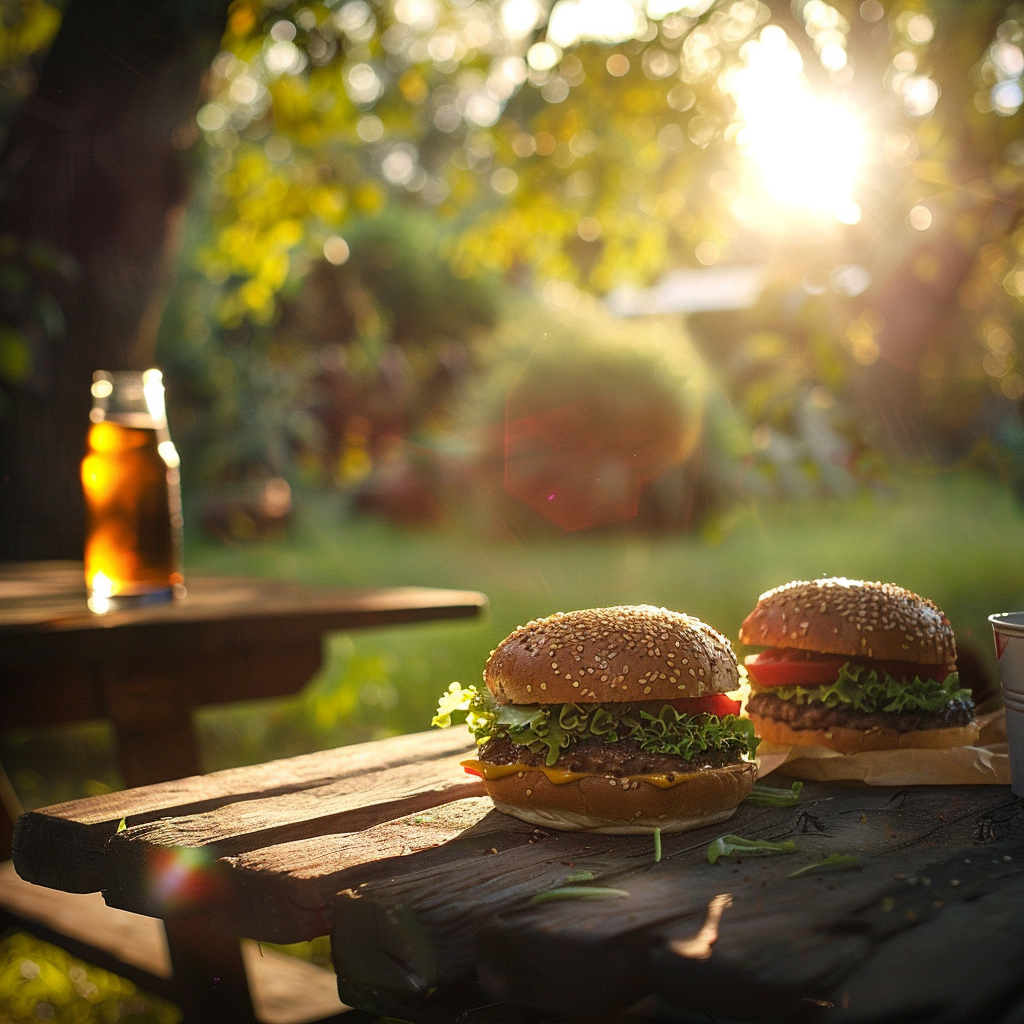
When you want to snap a picture of a burger that looks absolutely real and mouth-watering, go for sunlight. It showcases the colors and details in a burger like nothing else, making it more tempting and realistic. Aim for the golden hours, a bit past dawn or just before dusk, to catch that soft, warm glow that makes any burger look tasty. Keep your burger close to a window where soft natural light can hit it just right without making strong shadows.
Working with Shadows and Highlights
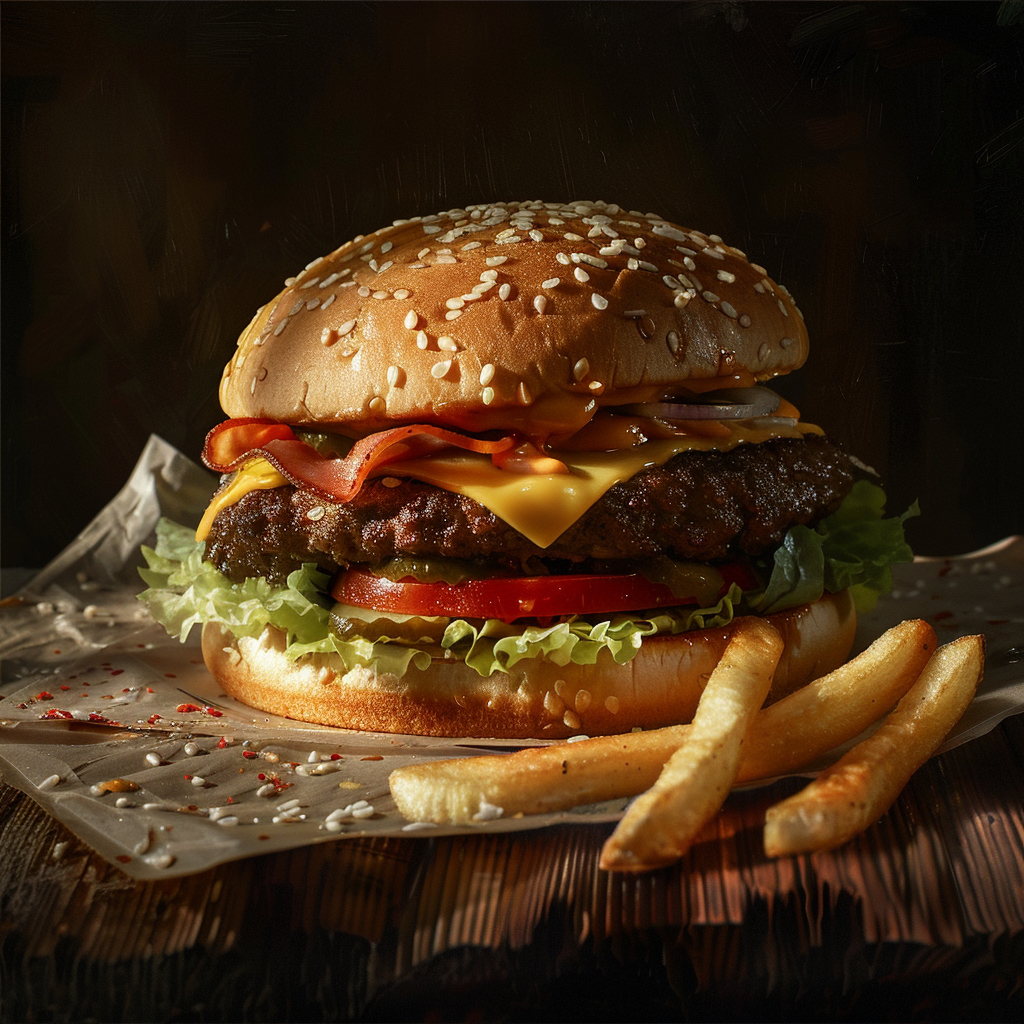
Using shadows and highlights can make your burger photos look more lifelike by creating a sense of depth. Pay attention to how the light shines on your burger, noticing the dark spots and bright spots. You can control these areas by bouncing light onto shadowed parts with white boards or reflectors, or you could use black boards, known as flags, to reduce too much light. Doing this will help you balance the light and dark contrast, which sharpens the details in each layer of the burger.
Controlling Exposure for the Right Mood
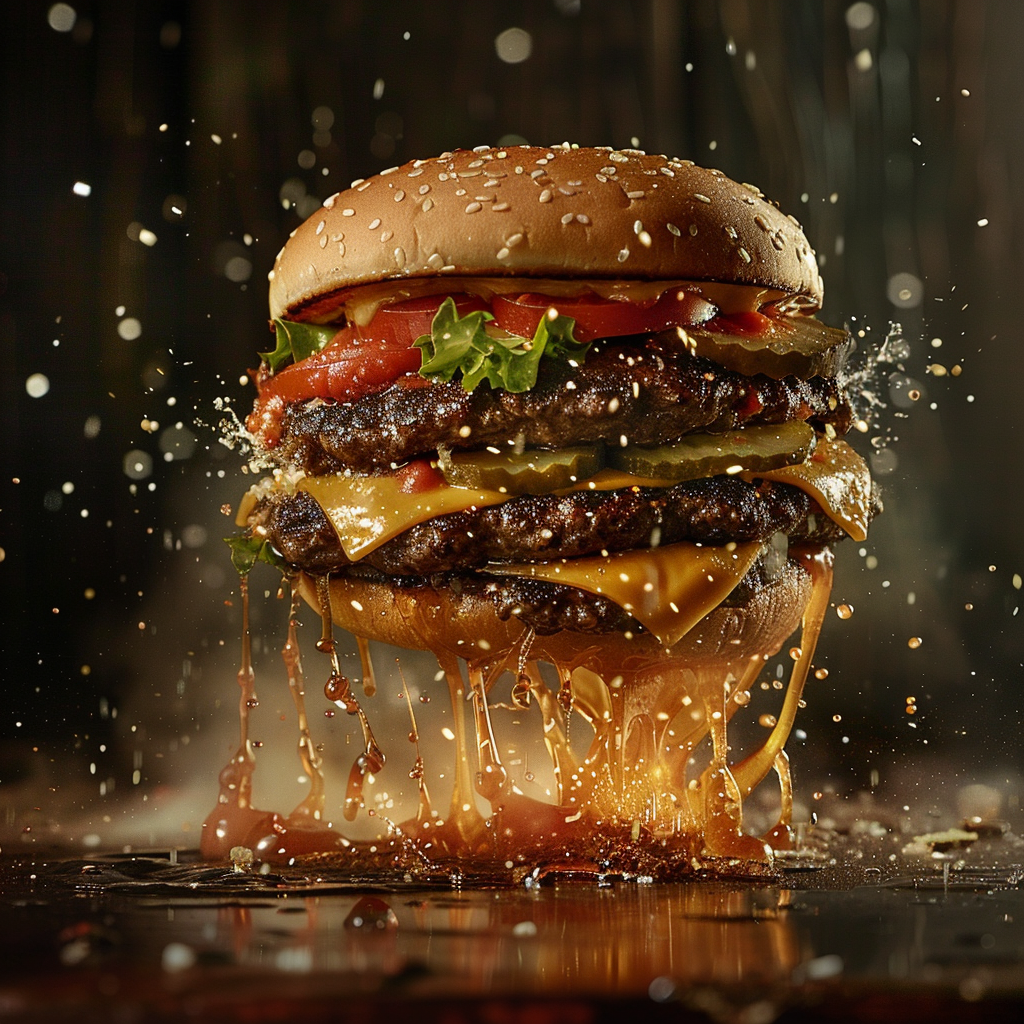
The feeling you get from a burger photo comes a lot from how light or dark it is. Photos that are too bright lose their charm and detail, and those too dim are hard to see. To set the exposure just right, look for where the burger looks its best with deep greens, rich browns, and cheese that’s just melted enough. Play with your camera’s manual mode or the exposure adjustment to nail it. Sometimes, a touch of underexposure works because you can fix it up later to pop out the colors without messing up the quality.
Error deliberate: Be careful with tweaking exposure; it’s tempting to make it super bright, thinking it’ll look better, but don’t get fooled that ain’t always true.
Remember, in burger photography, we enhance what’s in front of us – a yummy burger. Watch those small details and adjust camera settings to make people hungry just by looking at your pictures.
To snap a drool-worthy burger pic start clean and neat with an untouched bun base. Then, add layers that catch the eye like fresh lettuce, bright tomatoes, and crisp onion rings. Angle the melting cheese just so, and give the bun top a quick toast for that grilled vibe.
Building the Burger for Visual Impact
A great-looking burger doesn’t just happen; it’s carefully put together. Everything should be stacked neatly, forming an appealing stack of different textures. Avoid flat fixings and squished buns—they turn people off.
Use sturdy ingredients like crispy lettuce for support and show off bits of the pickle or tomato for fun.
Color Contrast and Saturation
Different colors make your burger photos pop. Use contrasting shades like a tomato’s red against the lettuce’s green, which grabs attention and highlights parts of the burger. Pay attention to how intense the colors are; you want them just right—not dull, not over-the-top cartoony either.
Adding Textures to Enhance Appeal
Different textures in your burger add depth and keep it interesting. Lettuce that’s fresh, sauces that shine, and ground meat’s roughness draw people in. Stick some sesame seeds on the bun or put a cool plate underneath to add that finishing touch.
When your images are taken, make them truly standout with some editing tweaks after shooting.
Basic Editing Techniques for Burger Photos
Start by touching up brightness and contrast so your burger looks lively. Brightness reveals those little details while contrast makes the colors vibrant. But keep it real; aim for appetizing yet natural. Sharpening highlights the food textures and makes viewers crave that crunch or fluffiness.
Adjusting Colors and Contrast for Appetizing Results
Tweaking colors is key. Bump up the saturation for mouth-watering looks, but remember to keep the original hues for authenticity. Play with warming things up using the temp slider if you want that hot-off-the-grill look but watch out for odd skin tones in case you’ve got hands in your shot.
Cropping and Framing for the Perfect Finish
Last thing is cropping—get rid of distractions and zoom in on that delish burger without making everything squished up close. With framing, try the rule of thirds for shots that are easy on the eyes. Post-crop make sure everything in the photo adds to the main star – your irresistible burger.
Edit right to significantly boost how tempting your burger photos seem; these tricks can help you hit pro level. Always walk the line between keeping things natural and kicking up the wow-factor. After sprucing up, your burger pics won’t just look good to eat but also hard to swipe by!
Top Tips for Sharing on Social Media
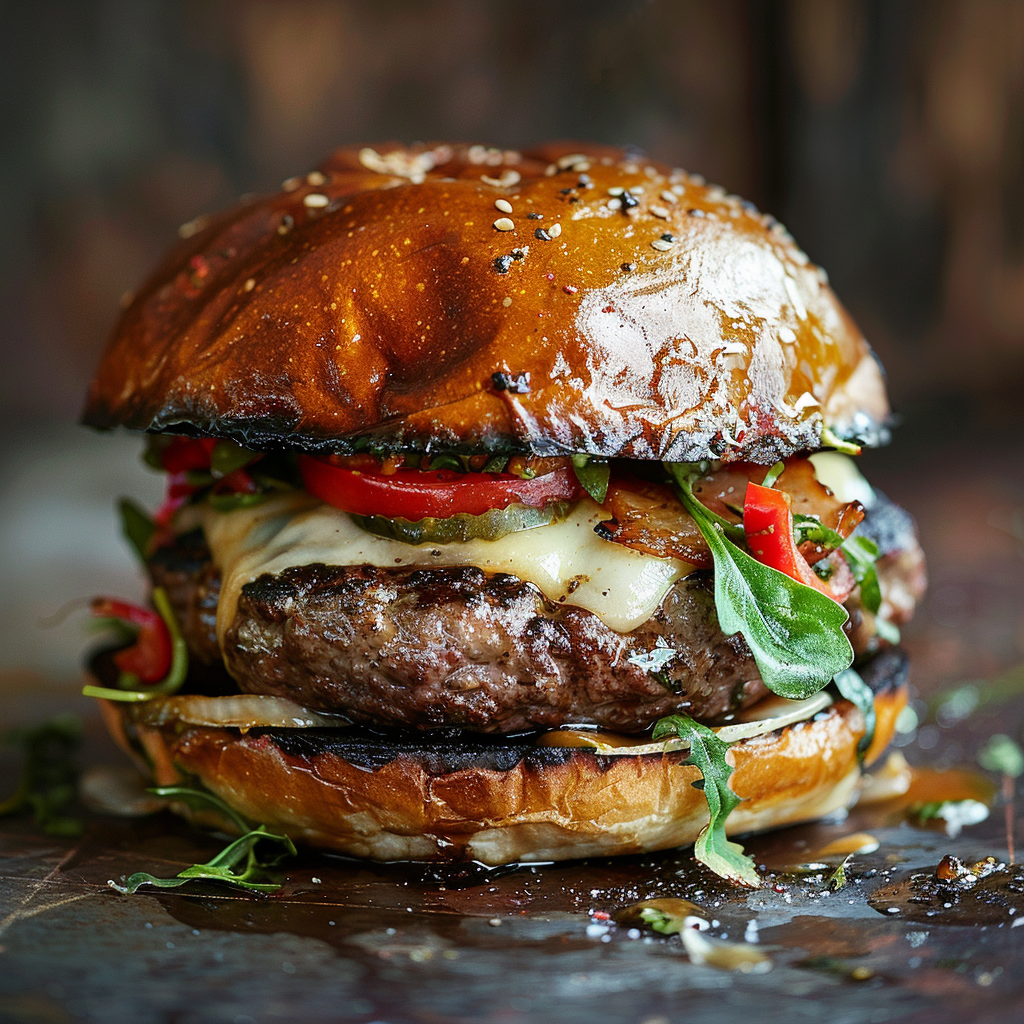
If you’re into taking pictures of burgers and sharing them online, it’s smart to know a few tricks to make your posts pop. First off, get your timing right; post regularly to stay in your followers’ minds. You’ve gotta use clear, sharp photos, and think about where you’re posting. Instagram loves a good-looking snapshot, while Twitter is all about clever comments. Add a bit of your own flavor by sharing a story or fun fact about your burger. Toss in some hashtags that hit the mark with the people you want to reach, but keep it chill–a handful of the right ones should do the trick. Remember to chat with the folks who comment on your stuff; this helps make a little community around what you do. And don’t turn a blind eye to what’s hot in the food world; tweak your posts so they’re more of what’s trending.
Tags & SEO: Get Your Burger Photos Seen
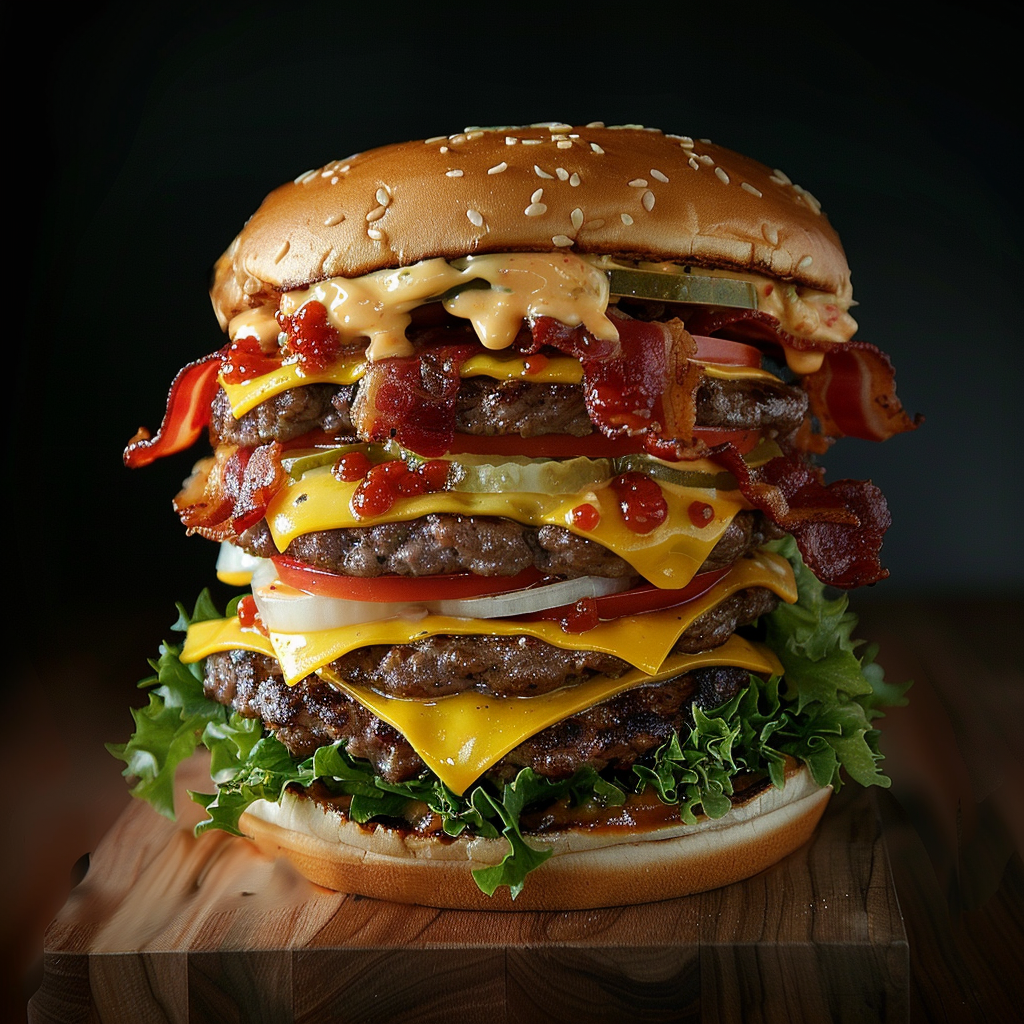
To ensure your burger photos pop up online, you’ve gotta nail SEO and tagging. Start by digging up keywords tied to your area of focus, think “juicy burgers” or “gourmet hamburger.” Weave these buzzwords into your post’s headline, rundown, and labels. Keywords are a big deal on places like Pinterest or blogs to bump up how often you’re spotted.
Don’t forget alt tags on your snapshots; they clue in search engines on what’s in your picture, helping them file it away right for folks searching. Plus, throw in specific tags for locations, eateries, or ingredients when it fits – it’ll tie your pic to people hunting for that sort of thing. If you tag and SEO right, burger lovers all over will have an easier time stumbling upon your work.
Joining the Food Photography Circle
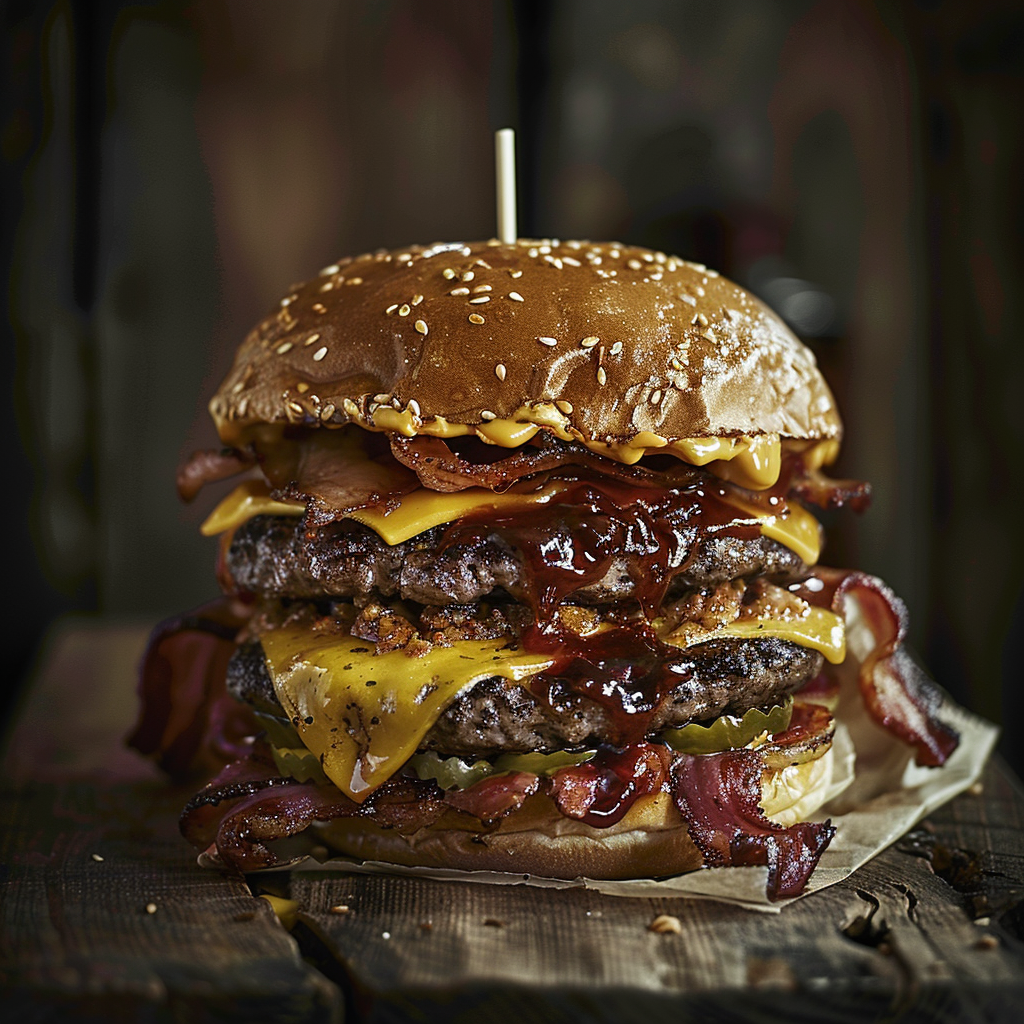
When you join the food photography world, it helps you learn and grow a lot as a photographer. Begin by following leaders and other photographers you look up to. Show interest in their work by leaving smart comments or asking stuff – that’ll start conversations.
It’s also a good move to become active in websites and group chats about food photography, because here you can swap advice, get feedback, and keep up with what’s new in the field. Don’t hold back from working with others; these partnerships are excellent for meeting new folks. And remember: whenever you interact, bring something to the table, like tips, kind words or fresh ideas. After all, real connections go both ways.
Frequently Asked Questions (FAQ)
How can burger photography benefit from the season's best produce?
Incorporating seasonal produce is not only a fresh take but injects vibrant colors and textures into your food pictures, making them more appealing to your viewers. For instance, a Summer Barbecue Ideas photo shoot could highlight bright elements like red tomatoes or green lettuce, adding a freshness factor that resonates with the season. Utilizing strawberries in a strawberry rhubarb jam as a burger condiment or a side of sumptuous cole slaw from your latest cole slaw recipe can make your images pop with color and authenticity. The freshness of these seasonal items can provide a visual representation of taste and quality, which is essential in advertising photographs to lure potential customers to choose one restaurant over another.
What's the key to creating a high-impact brown mushroom burger shot?
For an impactful brown mushroom burger image, start by focusing on enhancing the burger’s textures and colors. Brown mushrooms themselves are quite mellow in tone, so pairing them with vibrant ingredients from your pesto recipe or including accents like charred buns can add depth to your shot. It’s also helpful to use additional lighting techniques besides natural window light, such as a soft flash to bring out the subtle details of the mushrooms. Arrange your brown mushroom burger as the primary subject against a neutral background to ensure it stands out. Capture some test shots, and consult resources like ExpertPhotography for tips on adjusting exposure and creating a visual balance.
What techniques can emphasize the juicy details of a burger patty in photos?
To truly showcase the juiciness of a burger patty, proper lighting such as side-lighting can accentuate the shine and textures, thereby suggesting moisture and tenderness. A close-up detail shot using a macro lens adds depth and dimension to meat fibers and seasoning elements. Incorporate gloss-inducing elements like a light brush of oil or mayo, which catch the light just right — this technique reflects what fast-food chains often do for their advertising campaigns. Furthermore, a good tip is slightly undercooking the meat for photo purposes to maintain that juicy look since cooking fully can dry out the appearance. Remember, patience and several test shots are necessary to get that enticing food picture you’re aiming for.
Why should user-generated content not be overlooked in burger photography?
In today’s internet-driven world, user-generated content has become an invaluable tool for engaging with an audience and spreading word-of-mouth advertising. When users share their own photos of burgers from restaurants or their home-cooked versions using a certain recipe, it provides authenticity and relatable storytelling. These images may not always match the precision of professional burger photos, but they carry a ‘real-life’ appeal that resonates with people across platforms like 500px Blog or Instagram. Additionally, hashtags like #recipe or #burgerporn help in SEO and increase visibility for these images on the internet, making them highly useful for both personal bloggers and big-name brands alike.
Can DIY tutorials assist aspiring photographers in mastering burger photography?
Absolutely, step-by-step photography tutorials are an excellent resource for beginners and aspiring photographers looking to master the art of burger photography. Educational posts from sites like honestlyyum.com provide amateurs with critical techniques such as camera settings, styling practices, and post-production processes, thus equipping them with practical knowledge. These tutorials often break down complex photography elements into manageable parts that encourage experimentation with angles, lighting (including artificial lights), and composition. Importantly, guidance from these resources ensures that anybody interested in expanding their food photography skills can do so without needing access to high-budget equipment or professional training.
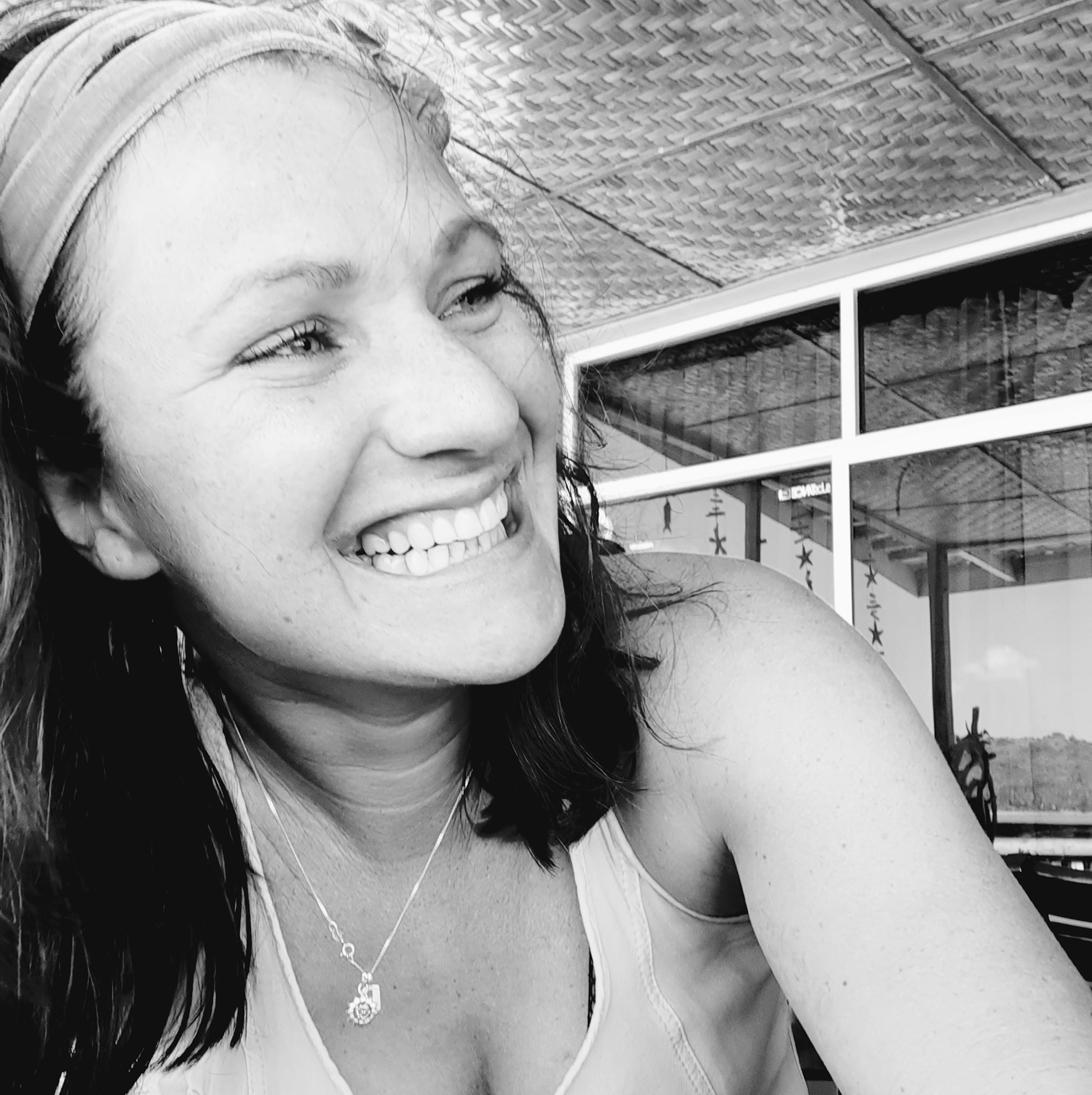
About Author
Rachel Noël is a professional photographer and videographer from the UK with over 10+ years of experience. Rachel specializes in Underwater, Tavel & Portrait photography among other areas.
